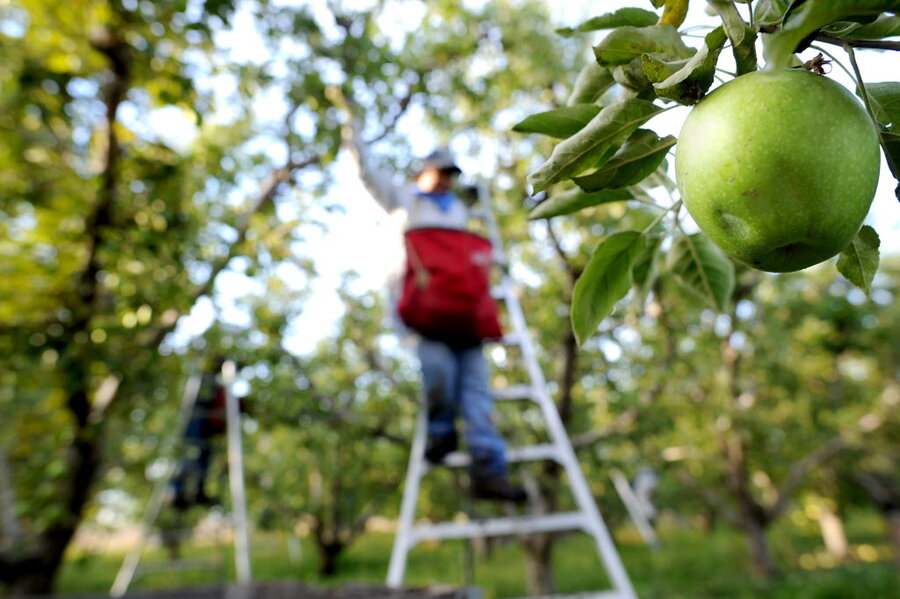Climate change means soft and sour apples, study finds
Loading...
Some 40 years ago, the Fuji apples that grew in orchards on Japan’s main island were full, sweet, and crisp. Now, those apples have become one more victim of global warming: picked today, apples from that region are mealier and sourer than ever before, according to a new paper published in Scientific Reports.
That climate change is souring and softening the apple is a well-known point: Each decade, German apples have bloomed about two years earlier than the last decade. Indian apple farmers have been pushed higher up the Himalayan flanks in search of the snowfall that feeds their Red Delicious trees. Researchers across North America have compiled anecdotal evidence that apples are changing across the continent.
But this Japanese study is the first to put numbers to those changes in apples, assigning values to the subtle changes in apple taste and texture over the last some four decades.
“Evidence of observed agricultural changes related to climate change has so far been confined to readily observable signals,” says Toshihiko Sugiura, a researcher at the National Agriculture and Food Research Organization in Fujimoto, Japan, and an author on the paper. “The effects on the flavour and texture of foods remained largely unknown, despite much public interest in this area.”
The researchers assessed careful records kept on Fuji apple orchards in the Nagano Prefecture on Japan’s Honshu Island, dating back to 1970. They also looked at data kept since 1975 on Tsugaru apple orchards in the Aomori Prefecture, just northward on the same island.
The Fuji apple, a Red Delicious and Virginia Ralls Genet hybrid named for the Japanese town, Fujikasi, where scientists engineered it back around 1930, is the world’s most cultivated apple. It is an unusually plump fruit, with a pinkish-colored skin that gives way to crisp and sweet flesh. The Tsugaru apple is a popular Japanese apple that ripens in September, some two months earlier than the Fuji.
Looking at those detailed records from two regions and on two apples, the researchers noted that the average air temperature in the apple cultivation regions rose about a third of a degree each decade in March and April, the period of maturation for the apple. At the same time, the apple trees bloomed earlier and earlier as the years passed.
Concurrent with those changes in climate and blooming date, the researchers also noted a gradual decline in those apples’ firmness and an increase in their sourness, the result of a loss of acid in their flesh.
“These results suggest that the qualities of apples in the market are undergoing long-term changes,” said Dr. Sugiura.
The changes in apples are imperceptible to most consumers – at least not yet, said Sugiura. Since the adjustments have been so gradual over the last 40 years, only someone with a sensitive palate and a good memory would remember that four decades ago, that apple tasted different than it does now – juicier and sweeter and fuller, with a satisfying, crisp bite to it. Otherwise, the best bet for telling the difference is to cruise in a time machine back to Japan circa 1970 and taste those apples, and then roll back to the present to take a comparative taste of the modern apple, said Sugiura.
“If you can eat an average apple harvested 30 years before and an average apple harvested recently at the same time, you can really taste the difference,” said Sugiura. “But most people should be unaware of the difference because of forgetting and large variations in individual fruits.”
In other words, the subtle signs of climate change have been literally right on our tongues, and we haven't even noticed.
Still, a different apple taste and texture might not be bad news for all consumers: the apples are becoming less sweet and less firm, but that doesn’t mean “becoming worse.” Some of the mealiest, creamiest, sourest apples – like the Cortland or the McIntosh – are best sellers around the world.
“Everyone has his own taste,” said Sugiura. “We don't think that these changes of apple fruits are always negatively impacting apple production.”
Even so, if consumers demand firm and sweet apples, apple growers will have to adapt new strategies for how, when, and where to plant their crops, he said.






